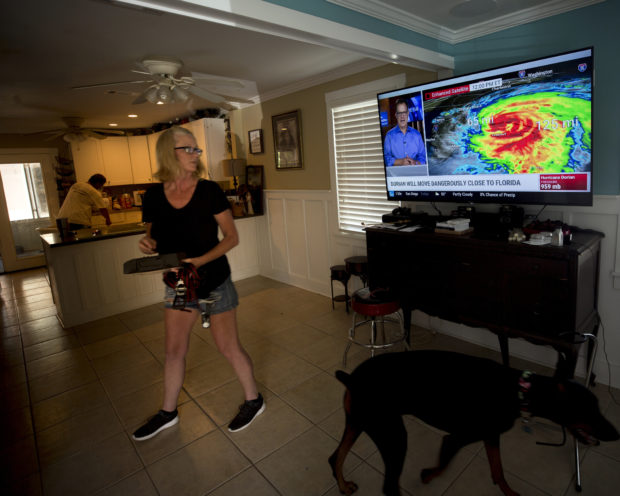Weather-tested residents brace for Dorian on Southeast coast
FOLLY BEACH, S.C. — Weather-tested residents along the coasts of Georgia and the Carolinas were using their experience with past storms to guide them Tuesday as they readied their homes for Hurricane Dorian and decided whether to heed evacuation orders.

Kristie Fisher, center, catches the latest on Hurricane Dorian on television at the home of her boyfriend Joey Spalding, back left, as they finish packing all of their belongings into a rental truck, Tuesday, Sept. 3, 2019, in Tybee Island, Ga. Last year Spalding’s home was flooded when Hurricane Irma pushed three feet of storm surge into his home. (AP Photo/Stephen B. Morton)
“Here we are,” said Ed Bandarovich as he strolled along sunlit Folly Beach outside of Charleston, South Carolina. “It’s a beautiful beach day, but who knows what tomorrow’s going to bring.”
Bandarovich, 70, recently moved to Johns Island, South Carolina, from Woodstock, New York, where he experienced the rare, devastating inland effects of Superstorm Sandy in 2012.
Bandarovich said he had been ready for Sandy’s power and its heavy rains but was caught off-guard by the 75 mph (121 kph) wind gusts that swept through the area in the storm’s wake. The winds scattered debris throughout his neighborhood, turned fallen boards and branches into projectiles and knocked out his power for days, he said.
“It’s all in the preparation, in being aware of what’s going to happen, or could happen,” Bandarovich said, noting that he had boarded up his Johns Island home just in case.
Dorian weakened to a Category 2 hurricane Tuesday after slamming into the Bahamas as a terrifying Category 5 storm with 185 mph (298 kph) winds.
Article continues after this advertisementPractically parking over the Bahamas for a day and a half, the storm pounded away at the islands Tuesday, devastating thousands of homes. At least five deaths were reported, with the full extent of the damage far from clear.
Article continues after this advertisementThe weakened storm pushed northwest at 5 mph (8 kph) with hurricane-force winds extending up to 60 miles (95 kilometers) from its center.
While weaker, the storm was continuing to grow in size, according to the National Hurricane Center. The threat of a direct hit on Florida had all but evaporated, but Dorian was expected to pass dangerously close to Georgia and South Carolina — and perhaps strike North Carolina — on Thursday or Friday.
South Carolina Gov. Henry McMaster ordered mandatory evacuations along the state’s 190-mile (306-kilometer) coast and turned all lanes of Interstate 26 into a one-way evacuation route heading west. Georgia officials did the same with Interstate 16 after Gov. Brian Kemp ordered coastal evacuations.
Attorney Henry Grimball, 71, said he and his wife would likely ride out Dorian in their narrow four-story home in Charleston’s downtown historic district.
“These houses have been here since 1770,” Grimball said, gesturing to the white and pastel houses dotting his neighborhood. “They’ve been through a lot.”
Grimball said he would reconsider, however, if the storm became a Category 3 or stronger hurricane: He remembers the devastation from Hurricane Hugo in 1989.
Hugo slammed into South Carolina’s coast with winds gusting as high as 108 mph (174 kph) in Charleston, killing several dozen people, causing nearly $6 billion in damage and toppling a massive magnolia in Grimball’s backyard.
“It gets to be really dangerous,” he said.
Forecasters and public officials were concerned that regardless of the storm’s strength, it could dump a dangerous amount of water on the Carolinas. /gsg